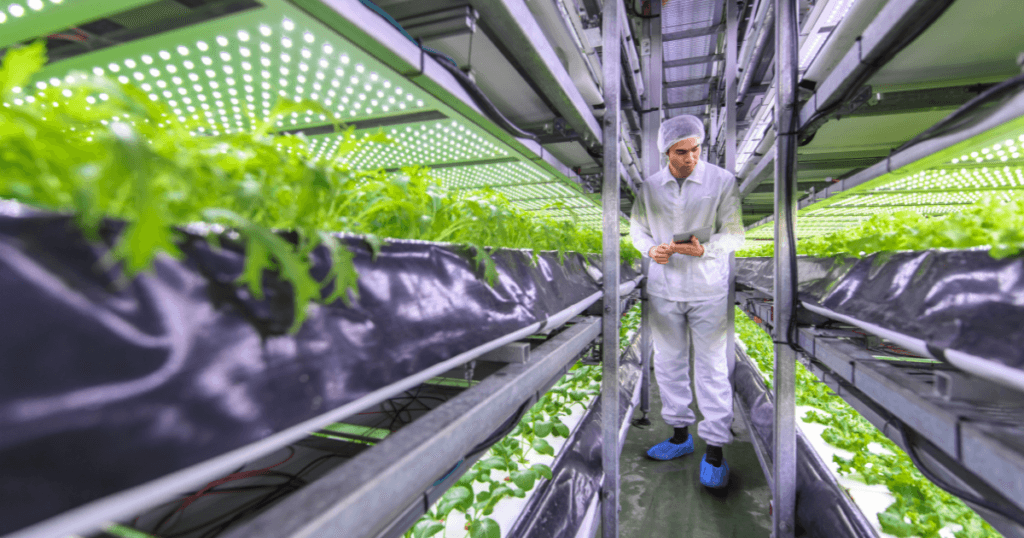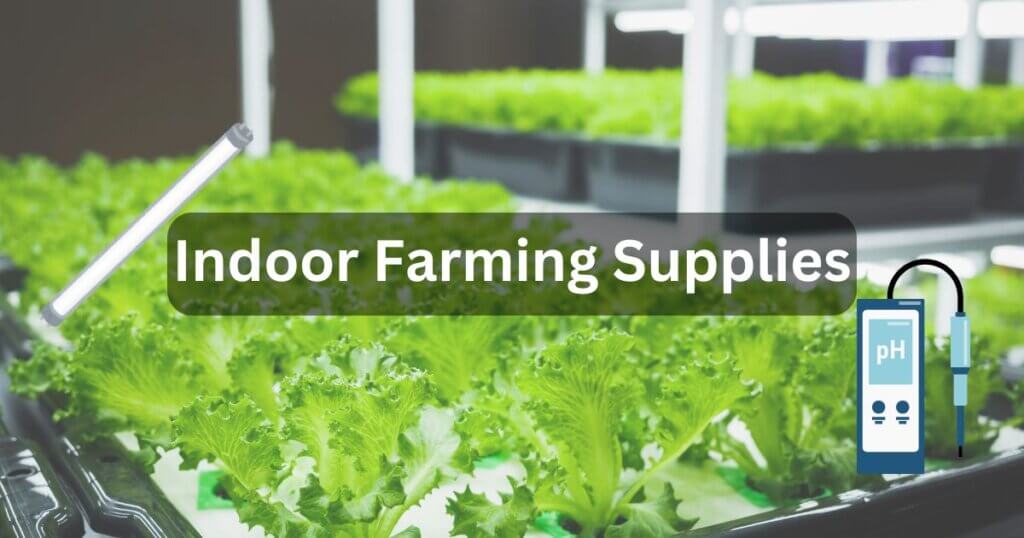Maximising Profits with High-Value Indoor Crops

Some of the links in this post are affiliate links. As an Amazon Associate, we earn a referral fee from qualifying purchases—at no extra cost to you.
Indoor farming has gained significant popularity recently due to its potential for high-value crop production. With the right selection of crops, cultivation techniques, and marketing strategies, indoor farmers can maximize their profits and tap into the growing demand for specialty crops. In this article, we will explore the world of high-value indoor crops and provide valuable insights on how to boost profitability in indoor farming.
Table of Contents
Understanding High-Value Indoor Crops
Defining High-Value Crops
High-value indoor crops are specialty plants cultivated in controlled indoor environments that command premium prices due to their distinct characteristics. These crops are often sought after for their rarity, unique flavors, medicinal properties, or specific health benefits. The market for high-value indoor crops is highly dynamic, driven by consumer demand for specialty products that cannot be easily found in traditional agriculture. Such crops include exotic herbs, rare vegetables, medicinal plants, microgreens, and edible flowers, all of which hold niche appeal and offer excellent profit potential for indoor farmers.
Assessing Market Demand
Before committing to high-value indoor farming, it’s essential to thoroughly assess the market demand for the crops you plan to grow. Conducting market research allows you to pinpoint trends, and consumer preferences, and identify potential buyers who are willing to pay a premium. Understanding local and regional demand patterns will help ensure that your crops align with market needs, which can significantly increase your chances of achieving profitability. This research is not only vital for crop selection but also for establishing long-term success in the competitive indoor farming industry.
Selecting Profitable High-Value Crops
Evaluating Profit Potential
When selecting high-value indoor crops, it’s important to consider their profitability and potential return on investment. Key factors to analyze include the cost of production, the market price of the crops, the yield per square foot, and how long it takes to grow the crop. The ideal high-value crop should balance low production costs with high market demand and substantial profit margins, making it a lucrative choice for indoor farming operations. Careful evaluation of these variables will ensure that the crops you choose can deliver a consistent and profitable revenue stream.
Tools like the pH and TDS Meter Combo are invaluable for fine-tuning water and nutrient quality, ensuring that your crop stays healthy and high-yielding.
Examples of Profitable High-Value Crops
Saffron is one of the most profitable high-value indoor crops, known as the world’s most expensive spice due to its labor-intensive harvesting process. Despite the high price tag, it requires minimal space and can be grown indoors year-round under the right conditions. Mushrooms, particularly gourmet varieties like oyster, shiitake, and morel, are another profitable choice for indoor farming due to their rapid cultivation cycle and high market demand. Microgreens, small but nutrient-dense greens, are increasingly popular in high-end restaurants and health-conscious markets, offering farmers a fast-growing crop with high returns and strong market appeal.
Consider starting with a user-friendly mushroom grow kit like the Back to the Roots Organic Mushroom Kit to explore gourmet mushroom cultivation at home.
Understanding Cultivation Techniques
Successful indoor farming requires mastering specific cultivation techniques tailored to each high-value crop. Factors like appropriate lighting, temperature control, humidity levels, nutrient management, and pest control are all critical components for ensuring optimal crop yields. By researching different cultivation methods and experimenting with variables like irrigation systems and soil types, you can determine the most effective techniques for each crop. This knowledge allows you to maximize productivity and achieve consistent results, which are crucial for running a profitable indoor farming operation.
For consistent results, consider investing in high-quality grow lights like the Spider Farmer SF-1000 LED Grow Light, designed for indoor crops with adjustable brightness and full-spectrum coverage.
Implementing Marketing Strategies
Building a Brand Identity
Creating a solid brand identity is a key strategy for increasing the profitability of high-value indoor crops. Developing a unique selling proposition (USP) will help distinguish your crops from the competition, making your product more appealing to consumers. By emphasizing factors such as the superior quality, sustainability, and distinctive characteristics of your crops, you can attract customers who are willing to pay a premium for your produce. Building trust through transparent practices and showcasing your commitment to high standards will foster long-term loyalty from your target market.
Targeting Niche Markets
One of the best ways to market high-value indoor crops is by focusing on niche markets that align with the specific qualities of your crops. High-end restaurants, specialty grocery stores, farmers’ markets, and online platforms focused on health-conscious consumers are prime markets for premium produce. By narrowing your focus and targeting these select segments, you can create a dedicated customer base that is willing to pay top dollar for your crops. This approach ensures that you are meeting the specific needs of these consumers, thereby allowing you to command higher prices and improve profitability.
Online Presence and Direct Sales
In today’s digital age, establishing a robust online presence is essential for expanding the reach of your high-value indoor crops. A well-designed website, along with active social media marketing, can significantly increase your visibility to potential buyers, both locally and globally. By utilizing e-commerce platforms, you can sell directly to consumers, eliminating the need for middlemen and allowing you to capture a larger portion of the profits. Direct sales also help build stronger relationships with customers, fostering trust and increasing repeat business from satisfied buyers.
A professional look helps build trust—consider using tools like the Canon EOS M50 Mark II Creator Kit for stunning photos and videos of your high-value crops.
Conclusion
Maximizing profits with high-value indoor crops requires careful crop selection, thorough market research, cultivation expertise, and effective marketing strategies. By aligning your crop selection with market demand, optimizing cultivation techniques, and targeting niche markets, you can tap into the potential of indoor farming and achieve higher profitability. Remember to continually monitor market trends, adapt to consumer preferences, and innovate your offerings to stay ahead in the competitive high-value crop market.
In summary, the key steps to maximizing profits with high-value indoor crops are:
- Understand the concept of high-value indoor crops and their market demand.
- Select profitable high-value crops based on profit potential and market trends.
- Master the cultivation techniques specific to each crop, optimizing factors like lighting, temperature, and nutrient management.
- Build a strong brand identity to differentiate your crops and highlight their unique qualities.
- Target niche markets that appreciate and are willing to pay a premium for specialty crops.
- Establish an online presence and explore direct sales channels to reach a broader customer base.
By following these steps and continually refining your strategies, you can unlock the full potential of high-value indoor crops and maximize your profits in the indoor farming industry.
FAQs – High-Value Indoor Crops
1. What are the startup costs for growing high-value indoor crops?
The costs vary depending on the crop, setup, and scale of production. Basic indoor farming setups can start at a few thousand dollars for small-scale operations using grow lights and shelving, while commercial hydroponic or vertical farming systems can cost tens of thousands.
2. Which indoor farming method is best for high-value crops?
The best method depends on the crop. Hydroponics and aeroponics are ideal for leafy greens and herbs, while mushrooms thrive in substrate-based systems. Vertical farming maximizes space efficiency, making it a popular choice for high-value crops.
3. Can high-value indoor crops be grown organically?
Yes, but achieving organic certification requires compliance with strict regulations regarding soil, fertilizers, and pest control. Many indoor growers use organic nutrients and sustainable practices to appeal to health-conscious consumers.
4. What are the biggest challenges in high-value indoor farming?
Key challenges include high initial investment costs, energy consumption for lighting and climate control, pest and disease management in controlled environments, and maintaining consistent market demand.
5. How do I determine the best price for my high-value indoor crops?
Pricing depends on factors like production costs, competitor pricing, demand, and target market. Premium pricing can be justified through organic certification, superior quality, and direct-to-consumer sales.
Interesting Articles on High-Yield Indoor Crops
- Aquaponics: Aquaponics combines aquaculture and hydroponics, allowing for the cultivation of vegetables and fish simultaneously. This method offers diverse and stable crops, including Chinese cabbage, lettuce, basil, roses, tomatoes, okra, cantaloupe, and bell peppers. It appeals to environmentally conscious consumers due to its organic and pesticide-free produce.
- Aeroponics: Aeroponics is an advanced plant cultivation technique where plants grow with their roots suspended in the air and misted with nutrients. This method allows for high-density planting without the use of pesticides, leading to efficient seed germination and precise environmental control.
- Hydroponics: Hydroponics involves growing plants without soil by using water-based mineral nutrient solutions. Plants commonly grown hydroponically include tomatoes, peppers, cucumbers, strawberries, lettuces, and herbs like basil, mint, cilantro, rosemary, and parsley. This method offers advantages such as reduced water usage and space efficiency.
- Indoor Saffron Cultivation: In Kashmir’s Pampore region, traditional saffron cultivation faces challenges due to climate change. To address this, indoor farming methods using tubes with moisture and essential nutrients have been developed, showing promising results in temperature resistance and reducing crop failure. This approach offers a climate-resilient solution for high-value saffron production.
- Edible Houseplants: Growing edible houseplants indoors can enhance home decor while providing fresh produce. Options include coffee plants, Australian beach cherry, acerola, star fruit, sapodilla, Australian finger lime, Meyer lemon, passion fruit, black pepper, orangeberry, and papaya. Each plant has specific care requirements and can offer unique flavors and health benefits.







